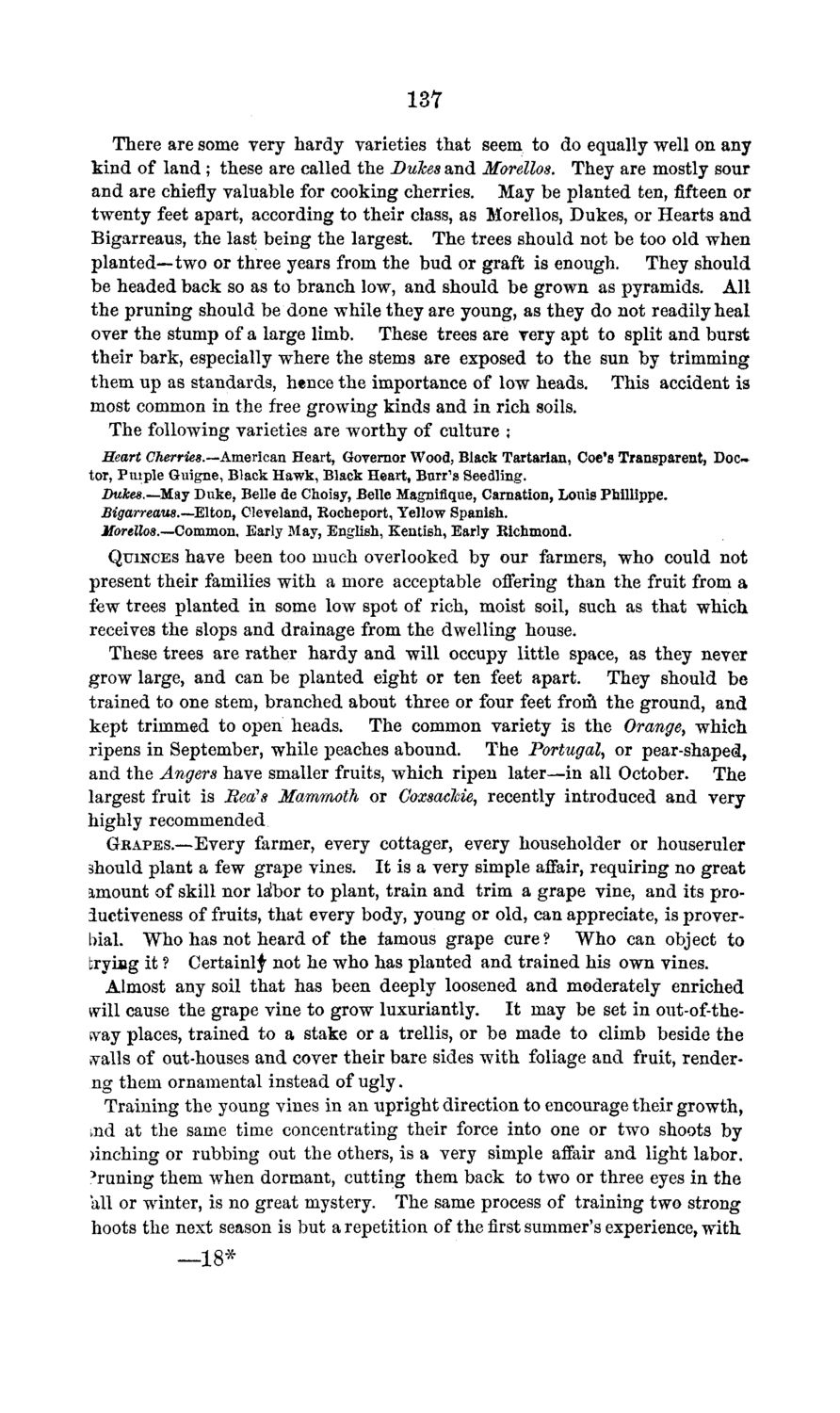| |
| |
Caption: Board of Trustees Minutes - 1869
This is a reduced-resolution page image for fast online browsing.

EXTRACTED TEXT FROM PAGE:
137 There are some very hardy varieties that seem to do equally well on any kind of land; these are called the Dukes and Morellos. They are mostly sour and are chiefly valuable for cooking cherries. May be planted ten, fifteen or twenty feet apart, according to their class, as Morellos, Dukes, or Hearts and Bigarreaus, the last being the largest. The trees should not be too old when planted—two or three years from the bud or graft is enough. They should be headed back so as to branch low, and should be grown as pyramids. All the pruning should be done while they are young, as they do not readily heal over the stump of a large limb. These trees are very apt to split and burst their bark, especially where the stems are exposed to the sun by trimming them up as standards, hence the importance of low heads. This accident is most common in the free growing kinds and in rich soils. The following varieties are worthy of culture ; Heart Cherries.—American Heart, Governor Wood, Black Tartarian, Coe's Transparent, Doctor, Puiple Guigne, Black Hawk, Black Heart, Burr's Seedling. Dukes.—May Duke, Belle de Choisy, Belle Magnifique, Carnation, Louis Phillippe. Bigarreaus.—Elton, Cleveland, Rocheport, Yellow Spanish. Morellos.—Common, Early May, English, Kentish, Early Richmond. QUINCES have been too much overlooked by our farmers, who could not present their families with a more acceptable offering than the fruit from a few trees planted in some low spot of rich, moist soil, such as that which receives the slops and drainage from the dwelling house* These trees are rather hardy and will occupy little space, as they never grow large, and can be planted eight or ten feet apart. They should be trained to one stem, branched about three or four feet from the ground, and kept trimmed to open heads. The common variety is the Orange, which ripens in September, while peaches abound. The Portugal^ or pear-shaped, and the Angers have smaller fruits, which ripen later—in all October. The largest fruit is Ilea's Mammoth or Coxsaclrie, recently introduced and very highly recommended GKAPES.—Every farmer, every cottager, every householder or houseruler should plant a few grape vines. It is a very simple affair, requiring no great amount of skill nor latoor to plant, train and trim a grape vine, and its proiuctiveness of fruits, that every body, young or old, can appreciate, is proverbial. "Who has not heard of the tamous grape cure? Who can object to trying it ? Certainly not he who has planted and trained his own vines. Almost any soil that has been deeply loosened and moderately enriched wdll cause the grape vine to grow luxuriantly. It may be set in out-of-thetvay places, trained to a stake or a trellis, or be made to climb beside the ^alls of out-houses and cover their bare sides with foliage and fruit, renderng them ornamental instead of ugly. Training the young vines in an upright direction to encourage their growth, tnd at the same time concentrating their force into one or two shoots by >inching or rubbing out the others, is a very simple affair and light labor. 3 runing them when dormant, cutting them back to two or three eyes in the all or winter, is no great mystery. The same process of training two strong hoots the next season is but a repetition of the first summer's experience, with —18*
| |